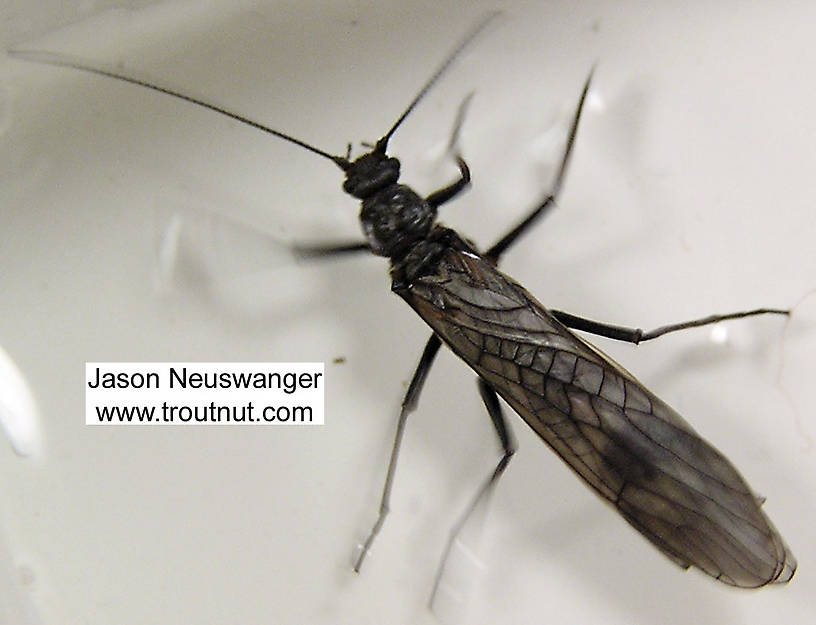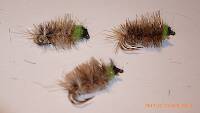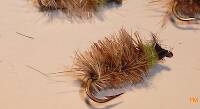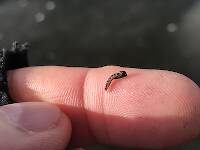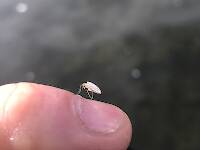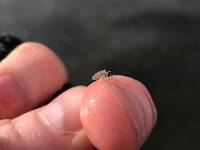
Blue-winged Olives
Baetis
Tiny Baetis mayflies are perhaps the most commonly encountered and imitated by anglers on all American trout streams due to their great abundance, widespread distribution, and trout-friendly emergence habits.
Featured on the forum

Troutnut is a project started in 2003 by salmonid ecologist Jason "Troutnut" Neuswanger to help anglers and
fly tyers unabashedly embrace the entomological side of the sport. Learn more about Troutnut or
support the project for an enhanced experience here.
Flybyknight on Dec 22, 2007December 22nd, 2007, 5:13 am EST
Strophopteryx fasciata is the second fly on my hatch chart; the first being Taeniopteryx navalis. Dreadful sounding names to be sure, conjuring up images of prehistoric monsters, but first seeing these benign little creatures bring me much happiness for the dawn of the fly fishing season has begun.
Schweibert discusses S. fascita on p. 64 in "Nymphs"
Often I see them in early March on snow banks and wonder how they can adapt to that. I fish my nymph ties on the bottom of fast riffles just before deep quiet pools, and have more success that way than with drys until about early May. At that time I sometimes have success fishing drys at the mouths of small feeder streams leading into the river.
Dick
Schweibert discusses S. fascita on p. 64 in "Nymphs"
Often I see them in early March on snow banks and wonder how they can adapt to that. I fish my nymph ties on the bottom of fast riffles just before deep quiet pools, and have more success that way than with drys until about early May. At that time I sometimes have success fishing drys at the mouths of small feeder streams leading into the river.
Dick
Lightly on the dimpling eddy fling;
the hypocritic fly's unruffled wing.
Thomas Scott
the hypocritic fly's unruffled wing.
Thomas Scott
Martinlf on Dec 22, 2007December 22nd, 2007, 1:39 pm EST
Dick, so you have a favorite pattern to share for the nymph?
"He spread them a yard and a half. 'And every one that got away is this big.'"
--Fred Chappell
--Fred Chappell
Flybyknight on Dec 22, 2007December 22nd, 2007, 3:03 pm EST
Hi Louis,
Yes I have a favorite pattern I would like to share.
It is a favorite of mine because I feel confident fishing it
in my home waters of the East Branch.
First I do not weight my nymphs, preferring to tie on to the tippet
with a loop knot, then adding very small split shot as needed
to get the little bugger on the bottom.
My tie for S. fasciata is a slight modification of the "Catskill
Curler", which can be found on p. 63 of Stewart's "Flies for Trout"
Hook: Mustad 9672 size 16 (3X streamer)
Tail: 2 peccary hairs.
Abdomen: Long barbs of darkest brown turkey tail twisted with
black thread.
Thorax: Peacock herl twisted with black thread.
Wingcase: Dark brown turkey tail section coated with vinyl cement,
(because vinyl is not as glossy as other cements).
Legs: phesant tail tied on the sides.
I do try and tie a prominent head.
BTW, I always tie a black fly larva as a dropper on all my offerings,
in this case a #20.
Standard Disclaimer: Yes I have been fly fishing for over 60 years, but I am not a good fisherman, and I do not claim the above tie to be any better than anyone else's, especially guys on this board, but thanks for asking.
Dick
Yes I have a favorite pattern I would like to share.
It is a favorite of mine because I feel confident fishing it
in my home waters of the East Branch.
First I do not weight my nymphs, preferring to tie on to the tippet
with a loop knot, then adding very small split shot as needed
to get the little bugger on the bottom.
My tie for S. fasciata is a slight modification of the "Catskill
Curler", which can be found on p. 63 of Stewart's "Flies for Trout"
Hook: Mustad 9672 size 16 (3X streamer)
Tail: 2 peccary hairs.
Abdomen: Long barbs of darkest brown turkey tail twisted with
black thread.
Thorax: Peacock herl twisted with black thread.
Wingcase: Dark brown turkey tail section coated with vinyl cement,
(because vinyl is not as glossy as other cements).
Legs: phesant tail tied on the sides.
I do try and tie a prominent head.
BTW, I always tie a black fly larva as a dropper on all my offerings,
in this case a #20.
Standard Disclaimer: Yes I have been fly fishing for over 60 years, but I am not a good fisherman, and I do not claim the above tie to be any better than anyone else's, especially guys on this board, but thanks for asking.
Dick
Lightly on the dimpling eddy fling;
the hypocritic fly's unruffled wing.
Thomas Scott
the hypocritic fly's unruffled wing.
Thomas Scott
Martinlf on Dec 23, 2007December 23rd, 2007, 6:48 am EST
Thanks, Dick. It looks like a great tie. Uh oh, now you have me wondering about the black fly larva. Would you share your pattern for this one? In return I'll point you to the thread that has my favorite ties on it--or better still I'll try to resurrect the thread. Perhaps you'll find something of interest.
"He spread them a yard and a half. 'And every one that got away is this big.'"
--Fred Chappell
--Fred Chappell
Flybyknight on Dec 23, 2007December 23rd, 2007, 11:07 am EST
Hello Louis,
Let me refine my previous post; I always tie on a midge pattern as a dropper, but the Black fly larva and Griffith's gnat predominate, because I believe the East Branch to be "Midge City"
My tie for the Black Fly Larva is borrowed right out of "Midge Magic"
by Holbrook & Kock
EARLY SEASON
Hook 18 M3906B (1 XL nymph)
Hook 20 M 94840
Thread Black
Abdomen C&C 54 yarn (Coats & Clark thread)
Rib C&C 47 " " " "
MID & LATE SEASON
Hook 24 M94840
Thread Cream (I think that cream is a closer match where I fish)
Abdomen DMC 762 yarn (Lane Colbert Co.)
Rib White (Lion Brand White Multi 301; because it has tinsel)
Well I hope that I have not mis-led you. EB is tough.
Dick
Let me refine my previous post; I always tie on a midge pattern as a dropper, but the Black fly larva and Griffith's gnat predominate, because I believe the East Branch to be "Midge City"
My tie for the Black Fly Larva is borrowed right out of "Midge Magic"
by Holbrook & Kock
EARLY SEASON
Hook 18 M3906B (1 XL nymph)
Hook 20 M 94840
Thread Black
Abdomen C&C 54 yarn (Coats & Clark thread)
Rib C&C 47 " " " "
MID & LATE SEASON
Hook 24 M94840
Thread Cream (I think that cream is a closer match where I fish)
Abdomen DMC 762 yarn (Lane Colbert Co.)
Rib White (Lion Brand White Multi 301; because it has tinsel)
Well I hope that I have not mis-led you. EB is tough.
Dick
Lightly on the dimpling eddy fling;
the hypocritic fly's unruffled wing.
Thomas Scott
the hypocritic fly's unruffled wing.
Thomas Scott
Martinlf on Dec 24, 2007December 24th, 2007, 1:33 pm EST
No, Dick, you have not misled me; I've fished the East Branch and know what devils those fish can be. Thanks for the tips.
"He spread them a yard and a half. 'And every one that got away is this big.'"
--Fred Chappell
--Fred Chappell
Quick Reply
Related Discussions
Topic
Replies
Last Reply
6
Sep 11, 2020
by Martinlf
by Martinlf



